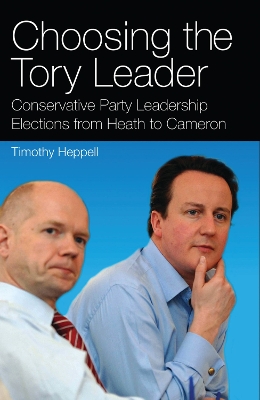International Library of Political Studies
1 primary work • 2 total works
Book 48
Choosing the Labour Leader: Labour Party Leadership Elections from Wilson to Brown
by Timothy Heppell
Published 1 January 2010
The means by which Labour Party leaders acquire their position determines their legitimacy and their authority over the parliamentary Labour Party and within the wider Labour movement. Understanding the rules governing Labour Party leadership selection and rejection, and the changing means by which respective leaders have been selected, is essential to an understanding of the development of Labour Party politics over the last fifty years. However, despite its centrality to the ideological, political and electoral identity of the Labour Party, the existing literature on Labour Party studies makes only limited reference to the means by which successive leaders actually acquired the party leadership.
Drawing together debates on the method of party leadership selection and the ideological positioning of leadership candidates, this book considers the candidates and campaigning strategies for each of the eight party leadership elections from the election of Harold Wilson in 1963 to Gordon Brown in 2007. Within this the ideological influences of the shift in the method of selecting the Labour Party leader, from an elite parliamentary ballot to a mass participatory Electoral College, are considered. In charting the decline of the left, Timothy Heppell here considers how the outcome of democratisation has been the intensification of the security of tenure of the incumbent, and the reverse of their intended effect of making the party leader more accountable to the wider Labour movement.
Given the bypassing of the Electoral College to anoint Gordon Brown in 2007, and the debates surrounding his authority and legitimacy as Labour Party leader thereafter, this book offers a comprehensive and timely examination of Labour Party leadership elections from Wilson to Brown.
Drawing together debates on the method of party leadership selection and the ideological positioning of leadership candidates, this book considers the candidates and campaigning strategies for each of the eight party leadership elections from the election of Harold Wilson in 1963 to Gordon Brown in 2007. Within this the ideological influences of the shift in the method of selecting the Labour Party leader, from an elite parliamentary ballot to a mass participatory Electoral College, are considered. In charting the decline of the left, Timothy Heppell here considers how the outcome of democratisation has been the intensification of the security of tenure of the incumbent, and the reverse of their intended effect of making the party leader more accountable to the wider Labour movement.
Given the bypassing of the Electoral College to anoint Gordon Brown in 2007, and the debates surrounding his authority and legitimacy as Labour Party leader thereafter, this book offers a comprehensive and timely examination of Labour Party leadership elections from Wilson to Brown.
v. 19
The means by which the Conservative Party have determined their party leadership has produced some of the most dramatic political theatre of the last four decades. The disputed succession to Harold Macmillan and the discrediting of the magic circle, the procedural changes designed to evict Edward Heath, the brutal political assassination of Margaret Thatcher, the bizarre resignation and immediate re-election of John Major, the putsch against lain Duncan-Smith and the ritual acclamation of Michael Howard, only to have him replaced by the unexpected election of David Cameron have demonstrated the capacity of the Conservatives for political intrigue.In this new evaluation Timothy Heppell assesses the way in which the Conservative Party have determined their leadership since the 1960s. By considering the events that led to each leadership election, the candidates standing and their campaigning strategies, he explains how and why respective victors were elected.
He argues the Conservatives have been maladroit when constructing their electoral procedures, they have returned unexpected party leaders, many of whom were to suffer from crises of legitimacy and accusations that they were default leaders. He observes how the dominance of ideology, as a destabilising influence on incumbents and a voting determinant in leadership elections, has been immensely disadvantageous to post-Thatcherite Conservatism.Rather than empowering incumbents to project their leadership credentials outwards to the electorate and against their Labour counterpart, successive post-Thatcherite Conservative party leaders have been forced to look inwards, devoting crucial time to the complexities of intra-party management and the threats against them from rivals from within the parliamentary party. Heppell concludes by asking whether the undisputed mandate and ideological pragmatism of David Cameron indicates that the Conservatives are learning from these mistakes in their own recent past.
He argues the Conservatives have been maladroit when constructing their electoral procedures, they have returned unexpected party leaders, many of whom were to suffer from crises of legitimacy and accusations that they were default leaders. He observes how the dominance of ideology, as a destabilising influence on incumbents and a voting determinant in leadership elections, has been immensely disadvantageous to post-Thatcherite Conservatism.Rather than empowering incumbents to project their leadership credentials outwards to the electorate and against their Labour counterpart, successive post-Thatcherite Conservative party leaders have been forced to look inwards, devoting crucial time to the complexities of intra-party management and the threats against them from rivals from within the parliamentary party. Heppell concludes by asking whether the undisputed mandate and ideological pragmatism of David Cameron indicates that the Conservatives are learning from these mistakes in their own recent past.

